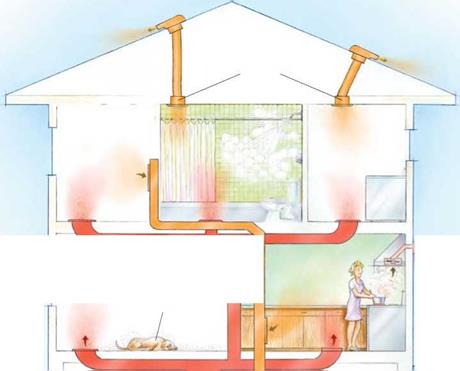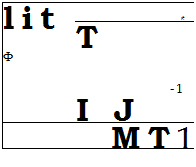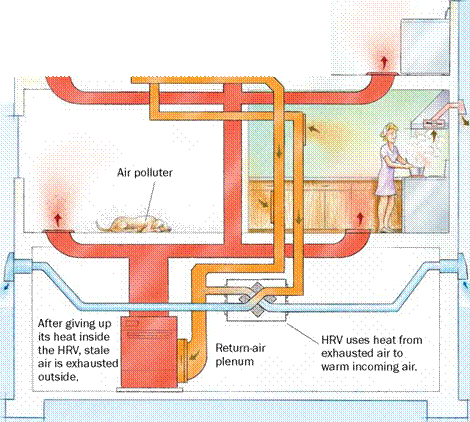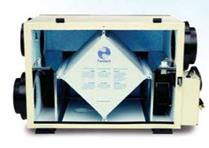Supply Ventilation Dilutes Pollutants Throughout the House
A supply system has the advantage of allowing you to select where the air comes from and how it is distributed throughout your home. For example, fresh air can come from a duct run connected to the return plenum of an HVAC system (see the drawing on the facing page). This way, outdoor air is pulled into the house through the air handler whenever it operates. Such an air intake must have controls (such as a timer or cycler) to turn on the air handler to make sure there is enough ventilation air. This system also should have a damper to prevent overventilating when the heating or cooling system is operating most of the time (very hot or very cold weather). Without these controls, this supply system is just a hole in the return duct, worse than a leaky house.
Supply systems must temper ventilated air to moderate temperatures in all but the mildest climates. When there is no heating or cooling call, the system above does this by running the air handler and mixing unconditioned outside air with large volumes of conditioned indoor air. While this process tempers the outside air, it uses a lot of electricity because the air-handler fan is overkill for the amount of ventilation air being sucked in.
 A Supply System Removes Bad Air and Brings in Fresh
A Supply System Removes Bad Air and Brings in Fresh
Houses with a forced-air heating system or with central air-conditioning have a built-in air-distribution network. A supply system uses it to distribute fresh outside air through the existing ductwork. But you still need exhaust fans in wet rooms. The best approach is a quiet, continuously running multiport vent fan in the attic that draws from several rooms (see p. 36).
Exhaust fan
![]()

 A separate range-hood vent fan is the simplest, best way to deal with contaminants from cooking.
A separate range-hood vent fan is the simplest, best way to deal with contaminants from cooking.
Fresh air is brought in through a separate duct running from the outside to the return-air plenum of the HVAC unit.
With a duct from outside the house to the furnace’s return-air plenum, fresh makeup air is drawn into the house by the furnace fan. A temperature – and humidity-sensing damper system (pictured at left) installed in the duct curtails airflow during very hot and humid or very cold weather.
A Balanced System Removes Bad Air, Brings in Fresh, and Can Save Heat (or Cold)




![]()

The problem with exhausting stale air from your house is that you’ve likely paid good money to heat or cool that air, and venting it directly outside is like throwing away money. A balanced system with a multiport vent fan (from $185 at www. sheltersupply. com
or www. iaqsource. com) channeling all exhaust through some type of heat
exchanger can mitigate the energy loss.

 ACTIVE EXHAUST AND INTAKE WITH ENERGY RECOVERY
ACTIVE EXHAUST AND INTAKE WITH ENERGY RECOVERY
The best approach to whole-house ventilation employs either a heat-recovery ventilator (HRV, from $700; see the photo at left) in cold climates or an energy-recovery ventilator (ERV, from $800) in hot climates. These units, which can be incorporated into a house with or without existing ductwork, bring in fresh air and exhaust stale air. In addition, an HRV tempers incoming air with outgoing air, thus lowering the amount of energy necessary to condition the fresh air. An ERV looks and functions similarly, but it dehumidifies and cools hot, humid air, which reduces the load on the air conditioner.
America’s First Residential Ventilation Standard
|
U |
ntil recently, not much had changed since 1631, when England’s King Charles I passed the first ventilation code (your dwelling had to have operable windows taller than they were wide). Because today’s houses aren’t leaky enough to provide fresh air, the American Society of Heating, Refrigerating and Air-Conditioning Engineers wrote a ventilation standard. ASHRAE 62.2 is a minimum standard applicable to both new and existing homes (including small multifamily ones). Keep in mind that 62.2 is a standard, not a code. Think of it as a recommendation that might lead to a new code requirement.
THE MAJOR REQUIREMENTS OF 62.2:
•WHOLE-HOuSE MECHANICAL VENTILATION
Ventilation can be achieved with an exhaust, supply, or balanced ventilation system. Ventilation airflow, measured in cubic feet per minute (cfm), must increase with the size of the house and the number of occupants. The 62.2 standard recommends minimum ventilation rates of 45 cfm for 2- to 3-bedroom houses up to 1,500 sq. ft.;
60 cfm for 2- to 3-bedroom houses between 1,500 and
3,0 sq. ft.; and 75 cfm for 4- to 5-bedroom houses between 1,500 and 3,000 sq. ft.
• mechanical exhaust in kitchens
AND BATHROOMS
In addition to the whole-house ventilation requirement: Kitchen: a user-operable vented range hood of at least 100 cfm; or a fan giving 5 kitchen air changes per hour of continuous or intermittent exhaust.
Bathroom: a user-operable fan of at least 50 cfm; or a continuously operating 20-cfm exhaust fan.
• minimum performance standards for fans
Volume: Fan’s airflow rates must be rated by a third party. Noise: Continuously operating fans should be 1 sone or less; intermittent-use kitchen and bath fans cannot exceed 3 sones.
•AIRTIGHT GARAGE DucT SYSTEMS
Air handlers or return ducts in an attached garage must be tested for tightness. While tight ducts save energy, 62.2 sets only minimum requirements to protect indoor-air quality.
• particle FILTRATION upSTREAM OF AIR HANDLERS
Dirty ducts and coils can become a pollution source, so 62.2 requires pleated furnace filters (MERV 6 or better). To clean the air inside a house, more-aggressive filtration is needed.







Leave a reply